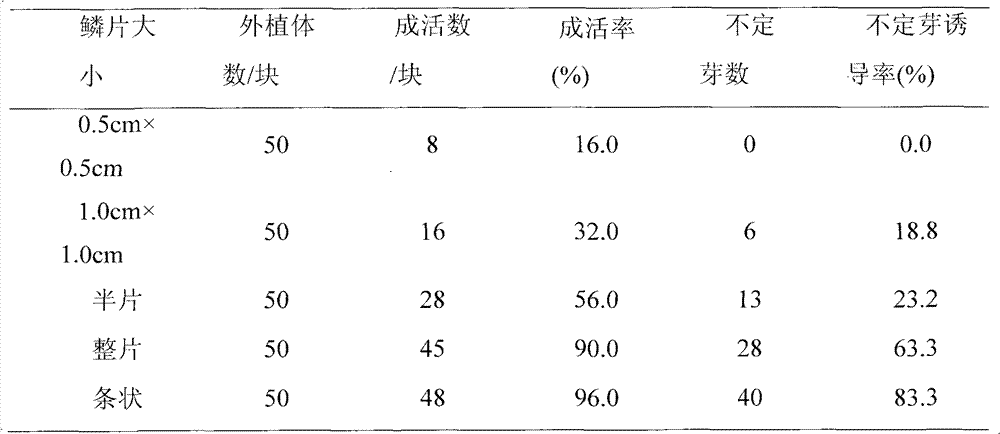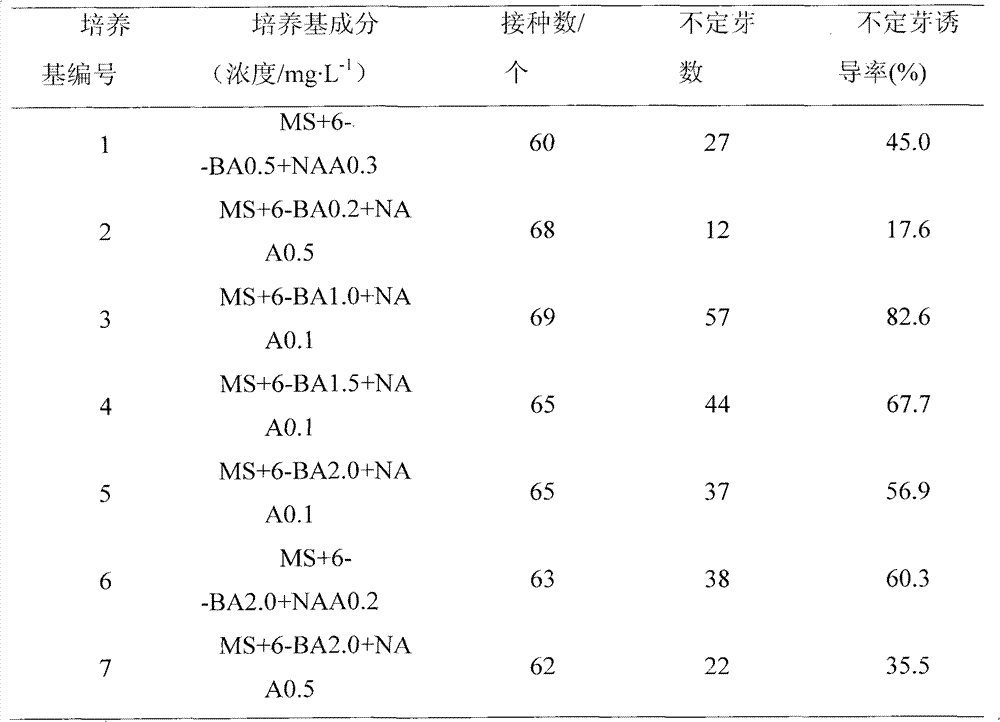Tissue culture method for lilium tenuifolium
A technology for tissue culture of Lilium chinensis, applied in the field of plant biology, can solve the problems of less research on tissue culture of wild lily, and achieve the effect of increasing the induction differentiation rate, increasing the induction success rate, and reducing the pollution rate
- Summary
- Abstract
- Description
- Claims
- Application Information
AI Technical Summary
Problems solved by technology
Method used
Image
Examples
Embodiment 1
[0030] Embodiment 1. The selection of Lilium fine-leaved explants and the influence of operation method on the induction of adventitious buds
[0031] 1. Materials and methods: The explants are the bulbs of Lilium tenifolia, and the bulbs are collected from the surrounding mountains of Hohhot, Inner Mongolia. The collection time is when budding or just sprouting in spring, and the explants are taken from the middle scales of Lilium tenifolia. Then sterilize the explants. The treatment steps are: wash the scales slightly to remove the soil → put them in a sterile container on the ultra-clean bench → add 2-3 drops of "Tween-20" to the detergent solution per liter Soak for 60 seconds → soak in 75% alcohol for 30 seconds → treat with 0.15% mercuric acid solution for 20 minutes → rinse with sterile water for 3-4 times → blot dry on sterile filter paper → directly access the pre-prepared in a good medium. It should be noted that the material should not be too much each time, and th...
Embodiment 2
[0045] Example 2. Screening of the optimal medium for each stage of Lilium microphylla tissue culture
[0046] 1. The effect of hormone concentration and its ratio on the induction of adventitious buds in Lilium microphylla
[0047] After the scales were inserted into the induction medium, about 40% of the scales turned purple-red after 3-7 days, then turned green and gradually formed small protrusions after 6-30 days, and about 90% of the scales turned green after 15-45 days The scales turn green. Adventitious buds were formed at the base, middle or upper part of the scales 30-55 days after turning green, but adventitious buds were often formed at the base, and almost no adventitious buds were formed at the upper part.
[0048] The scales are placed on MS medium containing different plant hormones and ratios. The culture environment is: culture temperature 25±1°C, light intensity 2500Lx, in addition to natural light during the day, supplementary light for 4 hours / day at nigh...
Embodiment 3
[0061] Embodiment 3. hardened seedling transplanting and greenhouse cultivation after Lilium fine-leaved rooting
[0062] The test-tube seedlings that grow robustly in the rooting medium and whose roots grow to 1-2cm are transplanted for hardening, firstly for 2 days of closed bottle hardening, then for 2-3 days of open bottle hardening, and then transferred to the greenhouse Plant. Carefully pour out the test-tube seedlings when transplanting, rinse the residual medium on the roots with clean water, dip the roots with 50ppm IBA for 8 minutes, and then plant them into the four substrates designed in advance. The results showed that vermiculite + sheep manure + diammonium phosphate had the best effect as the cultivation substrate, which was very suitable for the growth of seedling root system, and the transplanting survival rate could reach more than 80%. When the tissue-cultured seedlings grow to 3-4 true leaves, they can be moved into a false plant nursery for artificial pla...
PUM
 Login to View More
Login to View More Abstract
Description
Claims
Application Information
 Login to View More
Login to View More - R&D
- Intellectual Property
- Life Sciences
- Materials
- Tech Scout
- Unparalleled Data Quality
- Higher Quality Content
- 60% Fewer Hallucinations
Browse by: Latest US Patents, China's latest patents, Technical Efficacy Thesaurus, Application Domain, Technology Topic, Popular Technical Reports.
© 2025 PatSnap. All rights reserved.Legal|Privacy policy|Modern Slavery Act Transparency Statement|Sitemap|About US| Contact US: help@patsnap.com



